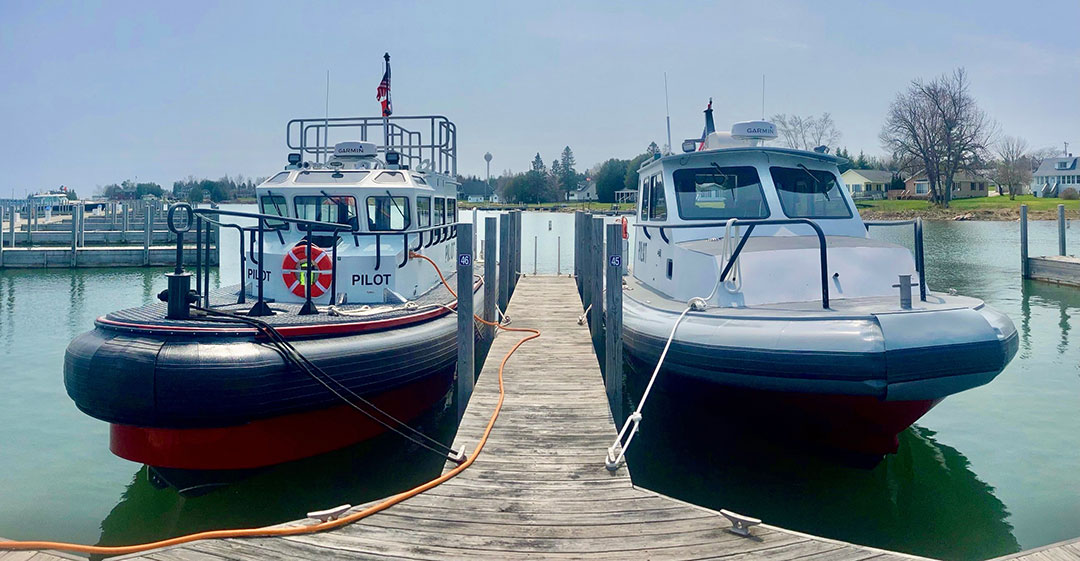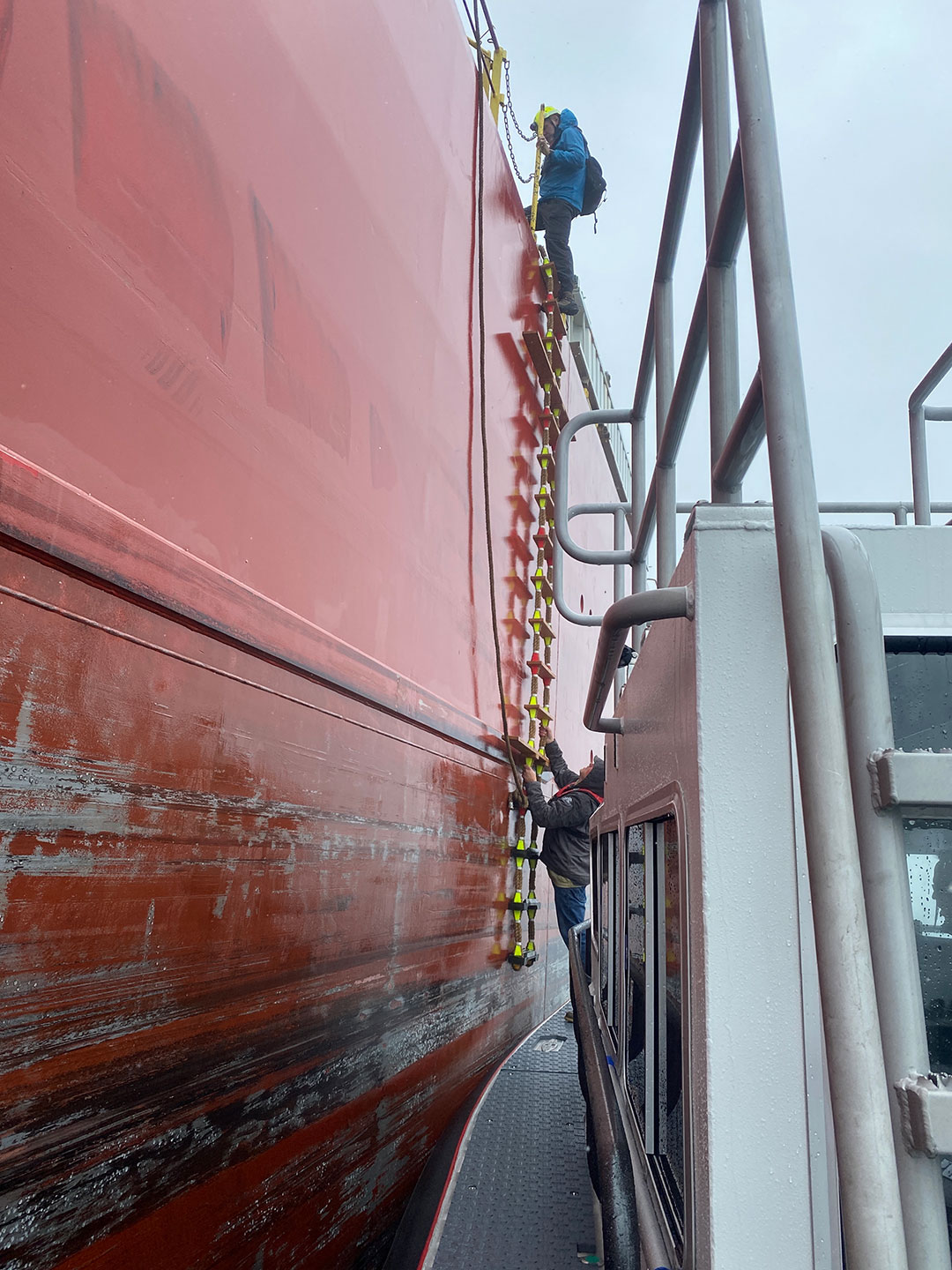
The 2022 Great Lakes shipping season is seeing some new boats plying the St. Mary’s River, which separates the western corner of Michigan’s Upper Peninsula and Canada. The Western Great Lakes Pilots Association (WGLPA) of Brimley, Mich., has added two vessels to its fleet of St. Mary’s River-based pilot boats, which numbers six vessels.
Pilotage District 3 on the Great Lakes encompasses the St. Mary’s River, Lake Superior, Lake Huron and Lake Michigan, for a total of over 8,200 miles of shoreline and over 77,000 square miles of water. The task of providing pilotage services over such a vast network of waterways is handled by 21 U.S. federally registered pilots and six Canadian pilots. Five additional apprentice pilots on the U.S. side are in various stages of training to eventually fill the shoes of upcoming pilot retirees.
The St. Mary’s River is the heart of District 3. The waterway itself separates Lake Superior from Lake Huron with about 70 miles of navigable channels. Included are the St. Mary’s Canal Falls (aka “Soo”) Locks, which facilitate the 23-foot elevation difference between Superior and Huron.
Great Lakes pilotage for vessels engaged in foreign trade are regulated under 46 CFR 401–404. These requirements include the mandatory swapping of pilots at designated change points to ensure adequate rest between pilotage assignments. Such change points are located at the upper and lower ends of the river system. Hence, the need for a reliable fleet of pilot boats capable of all-weather operations.

In remote corners of the district, contracting and/or local tugs may be used to handle a limited number of seasonal pilot transfers. However, WGLPA owns the St. Mary’s River-based pilot boats. These vessels in turn are managed under an operational/maintenance contract with St. Mary’s Marine Services. Western’s fleet totaled four boats prior to the 2022 season. The two primary boats were the aged 41-footers Soo Pilot and Western Pilot, which were Coast Guard utility vessels in a prior life. Another workhorse, Superior Pilot, is a small tug used for early and late season operations in ice. After its purchase and refurbishment, Superior Pilot entered service for Western in 2019. The oldest boat in the fleet is Linda Jean, a converted fish tug built in 1950, which has historically been utilized on the lower end of the river where the pilot boat runs are shorter. However, it is the two recent additions that are drawing attention and interest.
 The newbuild Waiska Pilot was ordered in 2020 from North River Boats in Oregon, delivered late in the 2021 season, and christened on April 28. The 37-foot Almar boat, powered by twin Suzuki 350-hp outboard engines, made its debut pilot run on May 25. Notable features of Waiska Pilot include a bow thruster, exterior heated deck pads, and state-of-the-art man overboard recovery gear.
The newbuild Waiska Pilot was ordered in 2020 from North River Boats in Oregon, delivered late in the 2021 season, and christened on April 28. The 37-foot Almar boat, powered by twin Suzuki 350-hp outboard engines, made its debut pilot run on May 25. Notable features of Waiska Pilot include a bow thruster, exterior heated deck pads, and state-of-the-art man overboard recovery gear.
Also seeing initial service with WGLPA is St. Mary’s Pilot, built in 2004 as Red Jacket, which was purchased from Penobscot Bay & River Pilots Association last fall. St. Mary’s Pilot is a SeaArk Dauntless 36, powered by Cummins twin diesel inboard engines (new in 2019) for a total of 750 hp. Coincidentally, St. Mary’s Pilot and Waiska Pilot were delivered to WGLPA on the same day.
For many years, District 3 pilots did not have a pilot boat dock above the Soo Locks, which resulted in lengthy transit times for pilot runs at the upper end of the river, often compounded by delays waiting for an open lock. Adding to these problems was the age and reliability of the former boats in use, which at times proved to be maintenance-intense.
In 2018, WGLPA acquired property in Brimley on the Waiska River, located about 11 miles southwest of the locks, and the company office was soon afterward moved from Superior, Wis. An adjacent lot with a vacant old house was purchased, and in time, the structure was razed to make room for a parking lot. WGLPA also has 18 company vehicles.
Perhaps the most important aspect of the move to Brimley is that the new pilot boat dock, only steps away from the office building, is located not only above the Soo Locks but just a quick 20-minute run to the federal pilot change point at buoy no. 33. A designated anchorage area borders the channel at the change point.
Moving the pilot boat operations above the locks did not come without challenges. A fixed road bridge with a vertical clearance of only 15 feet, 4 inches at datum crosses the Waiska River above the boat dock. This obstacle required modifications on the old 41-footers to allow the bulky masts to fold down. Once clear of the river mouth, the next hurdle entails navigating around patches of shallow water, a problem worsened by frequent drops in local water levels. Waiska Pilot was designed with a shallow draft and a lightweight foldable mast to eliminate these concerns.
Higher traffic volumes for District 3 are expected for the 2022 season, largely due to the return of passenger vessel service in the wake of the pandemic. Considering the ongoing challenges of handling traffic spikes, managing logistics in such a large pilotage district, and working in all weather throughout each season, one thing is certain: The St. Mary’s River-based pilot boat fleet is a key component in WGLPA’s ability to perform safe, efficient and reliable pilotage service.
Capt. Edyvean is the 1st Vice President of the Western Great Lakes Pilots Association.
